Let’s face it. There are too many professional books one can read in a lifespan. This list of People Analytics and HR-Tech books is not exceptional. I won’t be able to complete reading all of it, though I have these books on my Kindle, ready for browsing. I find here inspiration, blended with practical guidance and validation for my practices, mixed with new ideas and innovative tools, but most of all, an “open door” to a professional community, which I’m happy and honored to be a part of. So here is my People Analytics and HR-Tech reading list on Kindle (no paper books, as I like the trees), ordered chronologically from newest to oldest. Click titles for Kindle versions (Work in progress. First published: May 14th, 2018. Last update: March 30th, 2024. Total Kindle books mentioned: 79). If you are interested in additional free resources for data science and R programming, check the comment section of this post. And be careful! These books can change your career!
People Analytics – Build the Value Chain
Open Book (work in progress) by Littal Shemer Haim
The book is based on the Littalics.com blog posts from 2017 to 2022. It allows you to peek into the author’s thoughts and experience transitioning from an applied researcher to a People Analytics consultant and educator to HR. Enjoy Littal’s unique voice and take the time to contemplate, absorb ideas, and, hopefully, overcome barriers. You will find sixteen lessons in this book, organized into four milestones that, from the author’s experience, build the People Analytics value chain.
Strategic Workforce Planning: Best Practices and Emerging Directions

Marc Sokol, Beverly Tarulli (2024). “An overview of strategic workforce planning, covering best practices across organization types, geographies, and methodologies, and addressing new directions in the field. Contributors share case examples and experience-based insights, spanning the evolution of the field, best practices for analytics and consulting, maturity models, and when to organize around planning for future tasks vs planning for future roles. The Book also discusses changes in the workforce and workplace due to global disruptions like the COVID-19 pandemic and the impact of quickly evolving technologies, and re-examines the impact of strategic workforce planning on individual organizations and beyond.”
Data-Driven HR: How to Use AI, Analytics, and Data to Drive Performance *

Bernard Marr (2023). “AI is now an integral part of being data-driven. With this updated edition of Data-Driven HR, practitioners can unlock business potential and success through data and analytics. Covering topics such as recruitment, employee engagement, performance management, well-being, and training, HR practitioners can benefit from knowing how to be data-driven through data and AI. HR teams will learn to identify business goals, scrutinize useful data sources, and gain rich and diverse insights from their vast amounts of data. The book offers guidance on managing challenges that come with data and AI and how to responsibly and transparently use data to improve decision-making. It also includes predictive analytics and how to place warning systems into databases for any potential workforce issues.”
* The previous edition
The Fundamentals of People Analytics: With Applications in R *

Craig Starbuck (2023). “The book offers key concepts spanning the entire analytics lifecycle, along with step-by-step instructions for their applications to real-world problems, using ubiquitous and freely available open-source software, enabling to gain a deeper, data-informed understanding of organizational phenomena impacting the bottom line.”
* No Kindle version available, but free access to a PDF file.
Talent Assessment: Embracing Innovation and Mitigating Risk in the Digital Age

Tracy Kantrowitz, Douglas Reynolds, and John Scott (2023). “The intersection of new technologies, globalization, and market shifts among assessment providers has created dramatic opportunities for the field along with some significant challenges. Artificial intelligence (AI) and other technological advances have altered what is possible in talent acquisition. The book focuses on trends and innovations in talent assessment, framing practical solutions for managing the disruption in assessment while incorporating new insights and technologies into organizational assessment programs. It covers advances in the foundational science of assessment, technology-related innovations, updates to regulations, principles, and standards, and assessment for development.”
Introduction to People Analytics: A Practical Guide to Data-driven HR *

Nadeem Khan and Dave Millner (2023). “How can HR practitioners with little or no experience in analytics feel confident in their ability to find, analyze, and use workforce data to make better business decisions? This book provides expert guidance on the key aspects of analytics, enabling all HR professionals to handle employee and organizational data. It features new material on applying data to respond to external disruption and how to develop a people analytics journey. With updated case studies and thought leadership examples from leading companies, this book demonstrates how people analytics can be leveraged to improve culture and employee engagement, increase performance, and reduce costs.”
* The previous edition
Data & Analytics for Instructional Designers

Megan Torrance (2023). “With the advance of new learning technologies and data specifications, instructional designers have access to more and richer data sources than ever before. With that comes the question of what to do with the data. The book delves into the foundational concepts that will enable instructional designers and L&D professionals to use data in their roles. It defines key data and analytics terms, data specifications, learning metrics, and statistical concepts. It then lays out a framework for using learning data to plan how to gather data and build scale and maturity in your data operations.”
Data, Methods, and Theory in the Organizational Sciences: A New Synthesis (SIOP)

Kevin R. Murphy (2022) “This edition of the SIOP series explores the organizational sciences’ long-term evolution and changing relationships between data, methods, and theory. In the last 50 years, theory has dominated research and scholarship in these fields. Yet, the emergence of big data and the increasing use of archival data sets and meta-analytic methods to test empirical hypotheses has upset this order. This volume examines the evolving relationship between data, methods, and theory. It suggests new ways of thinking about the role of each in the development and presentation of research in organizations. This is an essential resource for researchers, professionals, and educators looking to rethink their current approaches to research and who are interested in creating more useful and more interpretable research in the organizational sciences.”
Network Psychometrics with R: A Guide for Behavioral and Social Scientists

Adela-Maria Isvoranu, Sacha Epskamp, Lourens Waldorp, and Denny Borsboom (2022). “A systematic, innovative introduction to the field of network analysis that provides a comprehensive overview of and guide to both the theoretical foundations of network psychometrics as well as modeling techniques developed from this perspective. The book features an introduction to the statistical programming language R that guides readers on how to analyze network structures and their stability using R.”
Inclusalytics: How Diversity, Equity, and Inclusion Leaders Use Data to Drive Their Work

Victoria Mattingly, Sertrice Grice, Allison Goldstein (2022) ” Whether due to pressure from internal and external stakeholders, competition for top talent, or a moral imperative, businesses increasingly acknowledge that DEI work needs to be done and done right. The book shares how modern businesses are using data to unlock DEI success. Employing a combination of case studies, practical examples, and step-by-step instructions, it guides DEI practitioners through developing a robust, data-centric approach to DEI. It provides instruction on gathering, analyzing, and reporting data to understand better the diversity, equity, and inclusion issues employees are experiencing and gain those workers’ trust. It demonstrates how companies can use the data to prioritize the issues they uncover, identify solutions, and evaluate whether the solutions they’ve chosen to spend time and money to implement are making a difference.”
Talent Tectonics: Navigating Global Workforce Shifts, Building Resilient Organizations and Reimagining the Employee Experience

Steven Hunt (2022) ” Shifting demographics combined with the digitalization of all aspects of life are transforming the nature of work. This forces companies to rethink how they design jobs and recruit, develop, and engage employees. This book explains how technology is changing the purpose of work and why creating effective employee experiences is critical to building organizations that can thrive in a world of accelerating change and growing skill shortages. The book explores how business strategy, organizational psychology, and work technology interact to create nimble companies.”
Talent Intelligence: Use Business and People Data to Drive Organizational Performance

Toby Culshaw (2022). “Improved access to people and business data has created huge opportunities for the HR function. However, simply having access to this data is not enough. HR professionals need to know how to analyze the data, what questions to ask, and where and how the insights from the data can add the most value. The book offers a practical guide that explains everything HR professionals need to know to achieve this. It also explains how and why talent intelligence differs from workforce planning, sourcing research, and standard predictive HR analytics. It also shows how to assess where talent intelligence can have the biggest impact and how to demonstrate the results to all stakeholders”.
Organizational Planning and Analysis: Building the Capability to Secure Business Performance

Rupert Morrison (2022). “The book offers a data-driven approach to workforce planning. It allows HR professionals, OD practitioners, and business leaders to monitor an organization’s activities and analyze business data to adjust plans to ensure the business succeeds regularly. This book covers building this function, the difference between strategic and operational workforce planning and managing demand and supply, matching people to new or changing roles, and developing robust succession planning. It also covers how to work with HR operations, including recruitment, L&D, reward, and performance management, and how human capital analytics allow a business to improve the return on investment for each employee”.
Humanizing Human Capital: Invest in Your People for Optimal Business Returns

Solange Charas, Stela Lupushor (2022). “The key to thriving through disruption is understanding and practicing human capital strategies that will drive enterprise performance and value-creation. The authors shift decision-making about people from a gut sense to an evidence-based approach. The book reveals a step-by-step method to apply analytics approaches to human capital while anticipating inevitable changes in the workforce landscape. This will enable human capital professionals to generate positive outcomes for all stakeholders and allow management to make decisions that work for the entire enterprise. This book compares “traditional” with the “future-forward” approach to human capital management, case studies, real-world situations, and 20 business principles”.
Handbook of Graphs and Networks in People Analytics: With Examples in R and Python

Keith McNulty (2022). “The book covers the theory and practical implementation of graph methods in R and Python for the analysis of people and organizational networks. Starting with an overview of the origins of graph theory and its current applications in the social sciences, the book proceeds to give in-depth technical instruction on how to construct and store graphs from data, how to visualize those graphs compellingly, and how to convert common data structures into graph-friendly form”.
Artificial Intelligence for HR: Use AI to Support and Develop a Successful Workforce *

Ben Eubanks (2022) “Artificial intelligence is changing the world of work. This book discusses how HR professionals can understand the variety of opportunities AI has created for the HR function and how best to implement these in their organization. From using natural language processing to ensure job adverts are free from bias and gendered language to implementing chatbots to enhance the employee experience, artificial intelligence can add value throughout the work of HR professionals. The book demonstrates leveraging this potential and using AI to improve efficiency and develop a talented and productive workforce. Outlining the current technology landscape and the latest AI developments, this book ensures that HR professionals fully understand what AI is and what it means for HR.”
* The previous edition
Humans at Work: The Art and Practice of Creating the Hybrid Workplace

Anna Tavis, Stela Lupushor (2022). “Technology, data analytics, and artificial intelligence already impact how people work and engage with organizations. A dispersed workforce, greater transparency, social change, generational shift, and value chain disruptions are driving new behaviors and expectations from the workplace. Together, these trends are shaping a new era of distributed and digitally enabled networks of workers where the work comes to workers instead of the workers going to work. The authors advocate for adopting human-centric practices as a critical and necessary part of adapting work and workplaces to the future of work and provide examples of how innovative companies are building workplace infrastructure and reshaping norms, serving new markets, and adopting new technologies”.
The Future of Recruitment: Using the New Science of Talent Analytics to Get Your Hiring Right

Franziska Leutner, Reece Akhtar, Tomas Chamorro-Premuzic (2022). “The book helps professionals, researchers, employers, and everybody interested in the world of work to understand the past, present, and future of recruitment. The authors describe the modern technologies and ideas that are changing recruitment, many driven by artificial intelligence. Evaluating ethical issues and highlighting how technology might be used to make recruitment and progression at work meritocratic, the book reflects on longstanding issues in recruitment and its role in building today’s unequal world of work”.
Introduction to HR Technologies: Understand How to Use Technology to Improve Performance and Processes

Stacey Harris (2021). “Technology can have huge benefits for the HR function: saving time by streamlining processes, boosting engagement by enabling analysis of people data or improving employee development by allowing staff to access the content they need on different platforms, wherever and whenever they need it. However, with more apps, software, and platforms than ever before, the volume and variety of available technologies can be overwhelming. The book offers a clear, accessible, and jargon-free guide for HR professionals to understand how to use technologies to add tangible business value. It covers all the core areas of HR including recruitment, performance management, learning and development (L&D), and reward. There is also discussion of artificial intelligence (AI), machine learning and the Internet of Things (IoT) and what they mean for HR”.
Introducing HR Analytics with Machine Learning: Empowering Practitioners, Psychologists, and Organizations

Christopher M. Rosett and Austin Hagerty (2021). “For today’s organizational psychologists to successfully work with their partners, they must go beyond behavioral science into the realms of computing and business acumen. Similarly, today’s data scientists must appreciate the unique aspects of behavioral data and the circumstances surrounding HR data and HR systems. Finally, traditional HR professionals must become familiar with research methods, statistics, and data systems to collaborate with these new specialized partners and teams. The book introduces these areas and guides on building the connectivity across domains required to establish well-rounded skills for individuals and best practices for organizations when applying advanced analytics to workforce data. It will also introduce machine learning and where it fits within the larger HR Analytics framework”.
Handbook of Regression Modeling in People Analytics: With Examples in R and Python

Keith McNulty (2021). “Despite the recent rapid growth in machine learning and predictive analytics, many of the statistical questions that are faced by researchers and practitioners still involve explaining why something is happening. Regression analysis is the best ‘Swiss army knife’ we have for answering these kinds of questions. This book is a learning resource on inferential statistics and regression analysis. It teaches how to do a wide range of statistical analyses in both R and in Python, ranging from simple hypothesis testing to advanced multivariate modeling. It is primarily focused on examples related to the analysis of people and talent, and includes a step-by-step guide and easily reproducible examples and code so that the methods can be put into practice immediately”.
The Science of Dream Teams: How Talent Optimization Can Drive Engagement, Productivity, and Happiness

Mike Zani (2021). “The book details a data-driven approach to talent optimization that makes hiring, motivating, and managing people more efficient and effective. It employs sophisticated assessments, tools, and software that enable leaders to: measure the traits and characteristics that predict success in a role or fit on a team, build finely tuned project teams and well-balanced leadership teams, boost employee productivity, engagement, retention—and happiness, unlock the hidden potential of individual workers and your organization as a whole”.
Excellence in People Analytics: How to Use Workforce Data to Create Business Value

Jonathan Ferrar, David Green (2021). “Effectively and ethically leveraging people data to deliver real business value is what sets the best HR leaders and teams apart. The book provides practical guidance on how to create sustainable business value with people analytics and develop a data-driven culture in HR. It allows HR professionals and business executives to translate their data into tangible actions to improve business performance while navigating the rapidly evolving world of work. Following a nine dimensions model, the book demonstrates how to use people data to increase profits, improve staff retention and workplace productivity as well as develop individual employee experience”.
HR Analytics Essentials You Always Wanted To Know

Michael Walsh (2021). “The book covers the following topics: Define what HR Analytics can do for an organization, Determine the best HR analytics role, Assess the readiness of organizations for undergoing a study using HR analytics, Apply HR Analytics in various HR disciplines, including recruiting and staffing, labor negotiations, incentives, and training, Use Excel to efficiently manage data for your HR analytics. The book walks readers through the many benefits of using analytics to make better people decisions. As it shows, HR Analytics is both an art and a science that can help organizations make informed decisions that benefit all stakeholders, including employees”.
Agile Workforce Planning: How to Align People with Organizational Strategy for Improved Performance

Adam Gibson (2021). “As business priorities change and focus shifts to address arising issues, HR professionals need to be able to reorganize talent swiftly and plan for future needs to enable the business to succeed. The book covers how to use agile workforce planning to forecast organizational demand for people, resources, and skills, and how to analyze and fill the gap between supply and demand. This is a practical guide for HR and organization development practitioners needing to align their staff, skills, and resources with evolving company goals. It also covers how to identify the skills needed in the workforce, where these skills are already available and when they’re missing, how to decide whether to buy, borrow or build them. It explains how to collect data to calculate and predict staff churn as well as how to use qualitative and quantitative demand modeling to forecast for future needs and provides strategies to address these including lateral internal recruitment”.
Digitalised Talent Management: Navigating the Human-Technology Interface

Sharna Wiblen (Editor) (2021). “The book focuses on the use of information technologies in talent management. It affords theoretically, methodologically, and empirically informed insights that are especially salient given the need for executives and organizations to balance the role of humans and technology while ensuring competitiveness in an interconnected and increasingly digital world. It contributes to the industry conversations about the role of technological innovations in enabling organizations to transition towards digital ways of organizing talent and the implications for different stakeholders. The book adds value by assembling subject matter experts currently siloed within traditional research domains while highlighting the complexity of managing talent”.
People Operations: Automate HR, Design a Great Employee Experience and Unleash Your Workforce

Jay Fulcher, Tracy Cote, Kevin Marasco (2021) “In this book, you’ll receive an end-to-end guide to Digitizing legacy HR functions, Using robots for the busywork you hate, Employing software to design and improve your employee experience, Assembling and empowering your “people team”, and Utilizing the included plans and templates to guide each stage of your business transformation.”
HR Analytics: Quantifying the Intangible: Linking People, processes, and analytics

Anshul Saxena (2021) “The book introduces the emerging discipline of ‘Human Resource Analytics’. The target audience is the students who have taken up bachelor’s and master’s degree programs in the field of management or enthusiasts who have even a wee-bit understanding of HR and are interested in diving deeper into the subject. The readers will develop insights into the topics like primary metrics, KPIs, and processes involved in different HR subdomains like recruitment and employee engagement.”
The ROI of Human Capital: Measuring the Economic Value of Employee Performance *

Jac Fitz-enz (2020) “The lifeblood of any business enterprise is its people. Yet it wasn’t until the publication of this groundbreaking book that there was a reliable way to quantify the contributions of people to corporate profit. Updated with new metrics, the book shows executives and HR professionals how to gauge human costs and productivity at three critical levels: organizational (contributions to corporate goals), functional (impact on process improvement), and human resources management (value added by five basic HR department activities). The book also includes topics such as corporate outsourcing, developments in behavioral science, and advances in trending and forecasting that have dramatically changed the way organizations measure the bottom line effect of employee performance.”
* The previous edition
Employee Surveys and Sensing: Challenges and Opportunities

William H. Macey, Alexis A. Fink (2020) “The design and execution of employee survey has evolved over the past decade. Technological advances and new interest in talent analytics have combined to create an exciting space with a good deal of innovation along methodological lines. Providing a solid grounding in the basic issues of content development, interpreting results, and driving action, the book addresses cutting-edge topics in the area of survey analytics, including applications of computational linguistics and artificial intelligence. Significant emphasis is given to ethical issues for ensuring the protection of data and the privacy of survey respondents”.
Solving the Productivity Puzzle: How to Engage, Motivate and Develop Employees to Improve Individual and Business Performance

Tim Ringo (2020). “The book is a practical guide for all people management professionals to address the challenge of stagnating people productivity. It covers how to embed learning and development activities to ensure that employees feel equipped with the skills they need to meet their goals, motivate a workforce made up of six generations with competing priorities, develop an effective workforce planning strategy to make sure the right people are in the right place at the right time, with the right motivation in the organization to build a company culture that allows people to thrive. It also includes expert guidance on how to implement change to opportunity in the workforce, track and measure productivity, and leverage new technologies to support employees.”
Digital HR Strategy: Achieving Sustainable Transformation in the Digital Age

Soumyasanto Sen (2020). “A crucial reading for HR practitioners and leaders about organization adaptation to changing and increasingly competitive environment. The book features case studies and covers the importance of cultural change and creating a human-centric employee experience, leveraging value propositions, and harnessing data insights and analytics to improve performance. It also explores frameworks, strategies, and opportunities for wellbeing initiatives, upskilling and reskilling workforces to respond to and establish a culture of collaboration and innovation”.
Measurement Demystified: Creating Your L&D Measurement, Analytics, and Reporting Strategy

David L. Vance, Peggy Parskey (2020) “The book breaks new ground with a framework to simplify the discussion of measurement, analytics and reporting as it relates to L&D and talent development practitioners. it helps practitioners select and use the right measures for the right reasons; select, create, and use the right types of reports; and create a comprehensive measurement and reporting strategy.”
Evidence-Based Recruiting: How to Build a Company of Star Performers Through Systematic and Repeatable Hiring Practices

Atta Tarki (2020) “Defending your business from the competition through regulations, differentiated technologies, brand recognition, and other methods is no longer a sustainable competitive advantage. This book guides you through the process of designing and implementing a data-driven hiring strategy that will secure your business for the foreseeable future. Revealing how today’s top innovators, it shows how you can do the same by implementing systematic and repeatable processes that lead to better, more consistent hiring outcomes. You’ll learn how to: envision an evidence-based approach to hiring, distinguish useful data from the data you don’t need, use the best technologies to achieve your recruitment goals, build an effective talent-acquisition team, improve on-the-job success predictions, design well-defined and objective measures to improve hiring outcomes, avoid the most common hiring pitfalls.”
Learning Analytics: Learning Analytics: Using Talent Data to Improve Business Outcomes

Cristina Hall, John R Mattox, Peggy Parskey (2020). ” Effective evaluation and measurement of learning and development initiatives are critical to maximize the impact of training, identify gaps for improvement and ensure that efforts are aligned to the business needs. The book outlines how analytical approaches can respond to these challenges, the types and benefits of technological solutions, and how to ask the right questions of organizational data in order to build a learning organization that boosts performance and competitive advantage.”
Fundamentals of HR Analytics: A Manual on Becoming HR Analytical

Fermin Diez (2019). “The future of the Human Resource Management profession is inextricably linked to understanding data analytics. The book provides practical, hands-on approaches to connect data to HR policies and practices to help influence overall business performance. It makes understanding and engaging with data analytics possible for professionals at all levels. Leveraging key statistical and financial concepts, including ROI and people productivity, and commonly available tools, it explores key skills and tasks in an accessible and illuminating way, including data-analytic thinking, data management, data collection, clean-up, and warehousing, building descriptive and predictive models, applying HR analytics skills and tools to workforce planning, recruitment, training, and turnover analysis”.
Investing in People: Financial Impact of Human Resource Initiatives

John W. Boudreau, Wayne F. Cascio, Alexis A. Fink (2019). “The future of work, talent, and employment are changing at an unprecedented pace, and organizational decisions about investment in people are under increasing scrutiny. Leaders’ decisions about human resources are crucial in an uncertain and interconnected world, yet decisions about people remain among the least systematic and evidence-based compared to resources such as money and technology. The book draws upon state-of-the-art practice and research across disciplines, including psychology, economics, accounting, and finance to provide HR professionals and leaders with proven guidelines for evaluating key HR initiatives. It is based on a comprehensive framework that clarifies and supports strategic linkages between investments in human capital and important outcomes that senior leaders most care about, such as talent acquisition, engagement, learning, customer service, and higher financial returns”.
Predictive HR Analytics: Mastering the HR Metric *

Martin Edwards and Kirsten Edwards (2019). “Organizational people-related data is an invaluable source of information from which to identify patterns to make effective business decisions. HR practitioners often lack statistical and analytical know-how. The book provides a clear, accessible framework for understanding People Analytics. It includes examples such as employee engagement, performance, and turnover. It shows how to use the results to develop effective evidence-based HR strategies. This 2nd edition has been updated to include machine learning, biased algorithms, data protection, GDPR considerations, and a new example using survival analyses. A new appendix shows main R coding and online resources consisting of SPSS and Excel data sets”.
* The previous edition
People Analytics & Text Mining with R
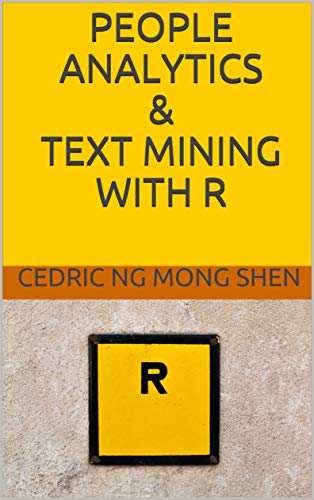
Mong Shen Ng (2019). “This book teaches you R (open-source programming language), People Analytics, Text Mining and Sentiment Analysis. It is written for people with no knowledge of R, with step-by-step print-screen instructions. The book covers the full People Analytics scope (Benefits, Compensation, Culture, Diversity & Inclusion, Engagement, Leadership, Learning & Development, Personality Traits, Performance Management, Recruitment, Sales Incentives) with numerous real-world examples, and shows how R can help”.
People Analytics for Dummies

Mike West (2019). “This book shows you how to collect data, analyze that data, and then apply your findings to create a happier and more engaged workforce: Start a people analytics project, work with qualitative data, collect data via communications, find the right tools, and approach for analyzing data”.
Human Capital Management Standards: A Complete Guide

Wilson Wong, Valerie Anderson, Heather Bond (2019) “A comprehensive guide to the BSI and ISO frameworks for people management, providing internationally agreed definitions and best practice guidance. The book covers everything from organizational governance, workforce planning, diversity & inclusion to learning and development. It explores the critical areas of people management throughout the employment life cycle, from initial hire to the time people move on from the organization. There is also coverage of additional business standards, such as those related to occupational health and safety, and the implications of implementing standards in a globalized and interconnected organizational context. The book also includes essential coverage of the standards assessment process and tips and advice on achieving successful accreditation.”
Human Resource Management: People, Data, and Analytics

Talya Bauer, Berrin Erdogan, David E. Caughlin, and Donald M. Truxillo (2018). “The authors introduce the fundamentals of talent management with integrated coverage of data analytics and how they can be used to inform and support decisions about people in an organization. Features tied to SHRM competencies and data exercises give readers hands-on opportunities to practice the analytical and decision-making skills they need to excel in today’s job market. Engaging examples illustrate key HRM concepts and theories, which brings many traditional HRM topics concepts to life”.
People Analytics. Data and Text Analytics for Human Resources

Eduardo Valencia (2018). “We have more information at our disposal about tastes, opinions, and certain behaviors that could be very useful in making decisions about performance, salaries, turnover rate, leaves of absence, etc. Accordingly, People Analytics processes that information through analysis tools that allow you to look at talent management decisions in a new way. People Analytics is based on data analysis as opposed to traditional methods of relationships or personal experiences. People Analytics offers a unique opportunity for human capital professionals to position themselves as strategic senior management partners, using analytically proven techniques to hire and retain employees who drive higher value in companies”.
The Practical Guide to HR Analytics: Using Data to Inform, Transform, and Empower HR Decisions
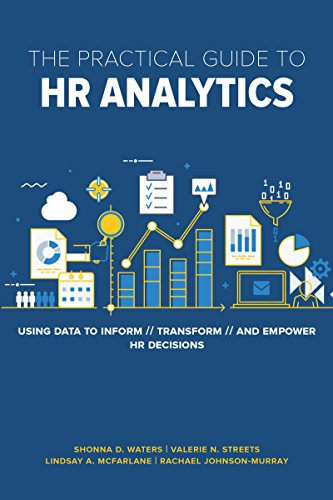
Rachael Johnson-Murray, Lindsay McFarlane, Valerie Streets, Shonna Waters (2018). “The need for HR professionals to understand and apply data analytics is greater than ever. Today’s successful HR professionals must ask insightful questions, understand key terms, and intelligently apply data, but may lack a clear understanding of the many forms, types, applications, interpretations, and capabilities of HR analytics. HR Analytics provides a practical approach to using data to solve real HR challenges in organizations and demystifies analytics with clear guidelines and recommendations for making the business case, starting an HR analytics function, avoiding common pitfalls, presenting data through visualization and storytelling, and much more”.
Digital HR: A Guide to Technology-Enabled Human Resources

Deborah Waddill (2018). “In times when HR leaders implement innovative technologies, such as Watson, AI, predictive modeling, and real-time analytics are being, this book can help. It offers the practical insights, real-world case studies, tips and tools, recommendations, and additional resources, to guide HR practitioners through each of the major technologies and to address vital strategic and implementation issues, that eventually enhance, enable, revitalize, and empower Human Resources”.
Human Resource Excellence: An Assessment of Strategies and Trends

Edward E. Lawler and John W. Boudreau (2018). “the book delivers new findings of what makes HR successful and how it can add value to today’s organizations. Tracing changes in a global sample of firms, it provides an international benchmark against which to measure a company’s HR practice. HR is most powerful when it plays a strategic role, makes use of information technology, and has tangible metrics and analytics. The authors offer insights about HR’s changing role in strategy, big data, social and knowledge networks, and the gig economy”.
Adaptive Space: How GM and Other Companies are Positively Disrupting Themselves and Transforming into Agile Organizations

Michael Arena (2018). “In this book, Michael Arena, an organizational networks expert who helped enable GM’s legendary turnaround, explains how to transform a company through the concept of adaptive space: enabling creativity, innovation, and novel ideas to flow freely among teams, across departments, and throughout the company. Using GM case study and other highly adaptive organizations, Arena provides a model to follow.”
Evidence-Based Management: How to Use Evidence to Make Better Organizational Decisions

Eric Barends, Denise M. Rousseau (2018) “The book has evolved with the goal of improving the quality of decision-making by using critically evaluated evidence from multiple sources – organizational data, professional expertise, stakeholder values and scientific literature. It sets out and explains the specific skills needed to gather, understand and use evidence to make better-informed organizational decisions.”
Strategic Workforce Planning: Developing Optimized Talent Strategies for Future Growth

Ross Sparkman (2018). “A playbook for workforce planning from beginning to end. It enables HR professionals to answer core business questions including how do I analyze future hiring demand? How do I assess what skills will be required in the future? How should I prioritize investments like training and development? How do I assess the supply of talent around the world? How do I identify the business drivers that impact workforce demand? It also covers the impact of artificial intelligence (AI), automation and machine learning on the global workforce and how to deal with these implications.”
Strategic Workforce Planning: Guidance & Back-Up Plans

Tracey Smith (2018). “The book aims to proactively plan to put the right people, in the right place, at the right time at the right cost in order to mitigate workforce risk. Written by the former head of global strategic workforce planning for FedEx Express, this basic introduction guides the reader through the planning framework and presents practical tools and approaches for successful implementation. It also discusses some of the major challenges of implementation facing leaders today”.
Doing HR Analytics – A Practitioner’s Handbook With R Examples
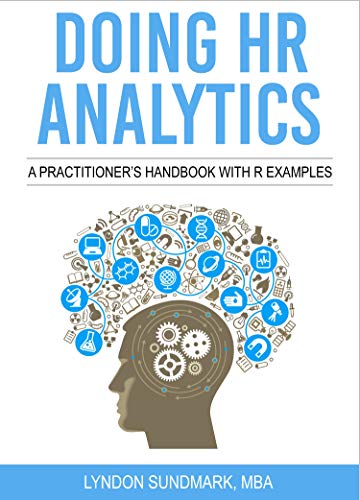
Lyndon Sundmark (2017). “The book seeks to cut through the jargon and hype that currently accompanies the current state of this field. It provides foundational definitions and concepts, a suggested ‘known’ analytics framework, and practical illustrative examples of how to use analytics to address HR issues. It gets you to think informationally about ‘all’ of HR and offers examples that ‘scratch the surface’ of what is possible.”
The Power of People: How Successful Organizations Use Workforce Analytics to Improve Business Performance

Nigel Guenole, Jonathan Ferrar and Sheri Feinzig (2017). “Drawing on incisive case studies and vignettes, three experts help you bring purpose and clarity to any workforce analytics project, with robust research design and analysis to get reliable insights. They reveal where to start, where to find stakeholder support, and how to earn “quick wins” to build upon.”
The Data-Driven Leader: A Powerful Approach to Delivering Measurable Business Impact through People Analytics

Jenny Dearborn and David Swanson (2017). “How to transform the HR function and overall organizational effectiveness by using data to make decisions grounded in facts vs. opinions, identify causes behind your company’s thorniest problems and move toward a winning, future-focused business strategy. Realistic and actionable, this book tells the story of a successful sales executive who, after leading an analytics-driven turnaround (in Data-Driven, this book’s predecessor), faces a new turnaround challenge as chief human resources officer.”
Competing on Analytics: Updated, with a New Introduction: The New Science of Winning

Thomas Davenport and Jeanne Harris (2017). “The roadmap for becoming an analytical competitor, this book shows how to create new strategies for organizations based on sophisticated analytics, introduces a five-stage model of analytical competition, and describes typical behaviors, capabilities, and challenges of each stage. It equally emphasizes human and technological resources, and contains examples from different industries and business functions”.
The Talent Delusion: Why Data, Not Intuition, Is the Key to Unlocking Human Potential
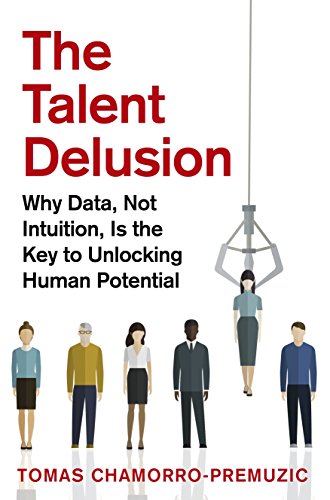
Tomas Chamorro-Premuzic (2017). “Bridging the gap between the psychological science of talent and common real-world talent practices, this book aims to educate HR practitioners and leaders on how to measure, predict and manage talent. It provides a data-driven solution to the common problems around employee selection, development, and engagement; how to define and evaluate talent; how to detect and inhibit toxic employee behaviors; and how to identify and harness leadership potential.”
Next Generation Performance Management: The Triumph of Science Over Myth and Superstition

Alan L. Colquitt (2017). “Business leaders and HR professionals focus on practices instead of the fundamental purpose of performance management. Standard economic and psychological theories for motivation and behavior fail to account for the increasingly complex nature of organizations and their environments today. This book confronts the traditional dogma, paradigms, and practices and holds them up to the bright light of scientific scrutiny. It encourages HR professionals and business leaders to abandon them and it offers up a more appropriate alternative paradigms to guide them and practical solutions that are better supported by scientific research.”
Quantifiably Better: Delivering Human Resource (HR) Analytics from Start to Finish

Steve VanWieren (2017) “The book provides a path to follow in search of answers to questions about turnover rate, leadership issues, engagement, and company culture. It offers help if you are just getting started with your HR analytics initiative or if you are looking for ways to expand your existing HR analytics practice.”
People Analytics in the Era of Big Data: Changing the Way You Attract, Acquire, Develop, and Retain Talent
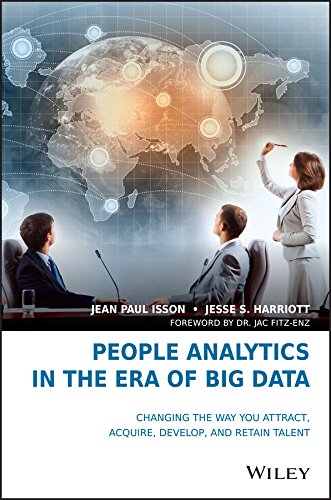
Jean Paul Isson and Jesse S. Harriott (2016). “This book presents a practical framework for real-world talent analytics, backed by groundbreaking examples of workforce analytics in action across the U.S., Canada, Europe, Asia, and Australia. Leverage predictive analytics throughout the hiring process, Utilize analytics techniques for more effective workforce management, Learn how people analytics benefits organizations of all sizes in various industries, Integrate analytics into HR practices seamlessly and thoroughly.”
Winning on HR Analytics: Leveraging Data for Competitive Advantage
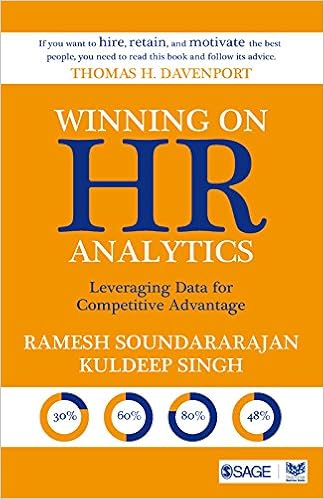
Ramesh Soundararajan and Kuldeep Singh (2016). “HR analytics is pivotal in identifying, measuring, and articulating the objectives and outcomes of different programs. Consider predicting which high performers were at risk of leaving six months before they walked out the door or triage incoming resumes overnight to predict employee success and tenure before you hire. It is possible with sophisticated technology and analytics, as demonstrated by companies such as Google, Walmart, and American Express.”
HR Analytics and Innovations in Workforce Planning

Tony Miller (2016). “Process approach to interviewing provides greater structure and has the potential for significantly reducing bias. The book demonstrates how to deter and filter poor performers and benefit from structured, prewritten score-able questions. The evidence shows that many HR functions have failed to understand the long-term financial consequences of poor performance or realize that talented people do much more work than other employees. This book gives a detailed guide to the nine-step process with work examples.”
Strategic Analytics: Advancing Strategy Execution and Organizational Effectiveness
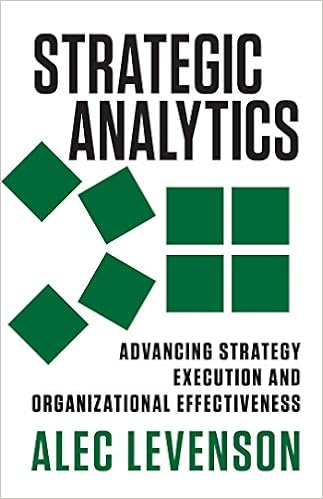
Alec Levenson (2015). “Business people who devise the strategies and the human resources people who get employees to implement them use completely different analytics. Business analytics can determine if operational priorities aren’t being achieved but can’t explain why. HR analytics reveal potentially effective policy and process improvements but can’t identify which would have the greatest strategic impact. This book shows how to use an integrated approach to bring these two pieces together.”
Optimize Your Greatest Asset – Your People: How to Apply Analytics to Big Data to Improve Your Human Capital Investments

Gene Pease (2015). “The author offers a framework for optimizing human capital investments through predictive analysis. You’ll learn how to transition from anecdotes and surveys to more advanced measurement techniques and combine the data from multiple systems into a unified plan of action that improves business results. The book includes practical examples and case studies to show how these techniques are applied in real-world settings, and executives and thought leaders weigh in on how advanced analytics are informing better business decisions every day.”
Work Rules!: Insights from Inside Google That Will Transform How You Live and Lead

Laszlo Bock (2015). “A compelling manifesto with the potential to change how we work and live, Laszlo Bock, Ex. Google’s Senior Vice President of People Operations offers both a philosophy of the new world of work and a blueprint for attracting the most spectacular talent and ensuring the brightest and best prosper.”
Making Human Capital Analytics Work: Measuring the ROI of Human Capital Processes and Outcomes

Jack Phillips and Patricia Pulliam Phillips (2015). “The tools and techniques you need to use analytics to show top decision-makers the value of HR in your organization. Focusing on three types of analytics, descriptive, predictive, and prescriptive, the book shows how you can apply analytics by Developing relationships between variables, Predicting the success of HR programs, Determining the cost of intangibles that are otherwise difficult to value, Showing the business value of particular HR programs, Calculating and forecasting the ROI of various HR projects and programs.”
Predictive Analytics for Human Resources

Jac Fitz-Enz and John Mattox (2014). “The book explains the basics of every business: the vision, the brand, and the culture, and shows how predictive analytics supports them. The authors put the focus on the fundamentals of predictability and include a framework of logical questions to help set up an analytic program or project, then follow up by offering a clear explanation of statistical applications.”
Predicting Success: Evidence-Based Strategies to Hire the Right People and Build the Best Team

David Lahey (2014). “A practical guide for using analytics to finding the perfect member for a team and avoiding bad culture fits, mismatched skillsets, entitled workers, and other hiring missteps that drain the team of productivity and morale. The book provides guidance toward implementing tools to build the best teams and achieve best outcomes.”
Employee Surveys That Work: Improving Design, Use, and Organizational Impact

Alec Levenson (2014). “Poorly designed employee surveys frustrate participants, analysts, and executives and can end up doing more harm than good. The book offers sensible, practical ways to make surveys more useful and accurate and provides specific advice for ensuring that the purpose and desired outcomes of surveys are clear, the questions are designed to provide the most relevant and accurate data, and the results are actionable. It also covers the best benchmarking practices, the benefits of multivariate modeling for analyzing results, the linking of survey data with performance data, the best ways to measure employee engagement, and the pros and cons of respondent anonymity.”
Developing Human Capital: Using Analytics to Plan and Optimize Your Learning and Development Investments

Gene Pease, Barbara Beresford, and Lew Walker (2014). “To make the most of your workers, nothing beats quantitative performance and investment measurement. To keep your business moving forward, effective management of human capital is crucial. It generates plenty of data, and deep analysis of this data helps you provide feedback and make adjustments to capitalize on the combined knowledge, skills, and creativity of your workers. The book provides a guidebook for collecting, organizing, and analyzing the data surrounding human capital so you can make the most of your employees’ potential.”
People Analytics: How Social Sensing Technology Will Transform Business and What It Tells Us about the Future of Work

Ben Waber (2013). “Sensors and analytics can give you an unprecedented understanding of how your people work and collaborate, and actionable insights for building a more effective, productive, and positive organization. The book covers cutting-edge case studies, e.g., changing the way call center employees spent their breaks to increase performance by 25% while significantly reducing stress, tweaking the balance of in-person and electronic communication to enhance the value of both and many more.”
The Talent Equation: Big Data Lessons for Navigating the Skills Gap and Building a Competitive Workforce

Matt Ferguson, Lorin M. Hitt, Prasanna Tambe (2013) “At every stage of the employee life cycle, a data-driven approach to HR can help companies make smarter decisions about their most important asset: their people. Companies face looming skill shortages, retention concerns, and questions regarding the most effective composition of their workforce. The book offers hiring professionals and business leaders a roadmap to attract and retain top talent. It covers a study of more than 2,700 employers and 33 million resumes to find the relationship between market performance, education attainment, and employee tenure. It explores the ROI of increased education levels and retention rates, the benefits of continuous recruitment and talent pipelines technology market, how workforce analytics tools are changing talent acquisition, and the importance of reducing long-term unemployment through training and reskilling.”
Applying Advanced Analytics to HR Management Decisions: Methods for Selection, Developing Incentives and Improving Collaboration

James C. Sesil (2013) “The author identifies widespread flaws in today’s HR decision-making processes and reveals how advanced analytics can help organizations make far more robust decisions about employee selection, performance management, strategy alignment, collaboration, and more. In this book, he shows how to integrate Business Intelligence, ERP, Strategy Maps, Talent Management Suites, and advanced analytics — and use them together to make far better decisions. The reader will learn how to measure and improve the value of HCM decision-making in workforce/succession planning, talent acquisition, career development, corporate learning, and beyond”.
Human Capital Analytics: How to Harness the Potential of Your Organization’s Greatest Asset

Gene Pease, Boyce Byerly, Jac Fitz-enz (2012) “Human capital analytics is the application of sophisticated data mining and business analytics techniques to human resources data. The book provides an in-depth look at the science of human capital analytics, giving practical examples from case studies of companies applying analytics to their people decisions and providing a framework for using predictive analytics to optimize human capital investments. The challenge of human resources analytics is to identify what data should be captured and how to use the data to model and predict capabilities so the organization gets an optimal return on investment on its human capital. The goal is to provide an organization with insights for effectively managing employees so that business goals can be reached quickly and efficiently”.
Positioned: Strategic Workforce Planning That Gets the Right Person in the Right Job

Dan Ward, Rob Tripp (2012) “The book captures the best workforce planning practices from leading organizations such as Boeing, HP, the US Intelligence Community, and others in the private and public sectors to help businesses address the constant challenge of having the right people available when needed in order to maximize creativity, efficiency, and productivity. By examining the evolution of workforce analytics and the roles of human resources professionals, and by incorporating input on best practices from expert people strategists, the authors provide insight into how organizations can adjust to turnover seamlessly and do so in a way that produces even better results.”
Calculating Success: How the New Workplace Analytics Will Revitalize Your Organization
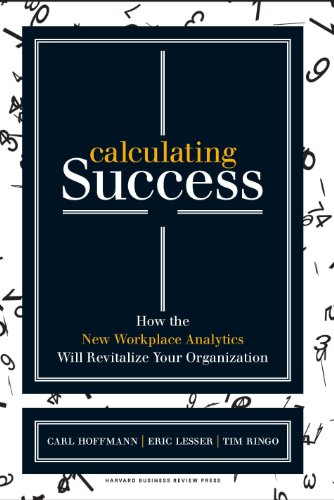
Carl Hoffmann, Eric Lesser, Tim Ringo (2011). “Most companies today have access to reams of data: marketing, supply chain, finance, as well as critical data about their workforce. Yet research shows that leaders at these companies lack the confidence to effectively integrate and use this data to compete effectively in the marketplace. While executives know the results they need to achieve, they often fail to analyze the impact of their decisions on the firm, its processes, and its people. The book shows how to can take an analytical approach to both anticipate and address the changes required by a company’s competitive environment and drive superior performance: Analyze the work that needs to be done and know how to structure it; Provide the right types of people to do it; Motivate them to engage in that work; Explore innovative ways to get the work done.”
Transformative HR: How Great Companies Use Evidence-Based Change for Sustainable Advantage

John W. Boudreau and Ravin Jesuthasan (2011). “Proven HR strategies that can have a real impact on organizational success. This book demonstrates how some of the world’s most admired and prominent organizations are redefining HR leadership by using evidence-based change to inform human capital decisions that optimize efficiency, effectiveness and strategic impact. The authors present the five foundational principles to the new HR decision science: Logic-driven analytics, segmentation, risk leverage, synergy and integration and optimization.”
Diagnosing and Changing Organizational Culture: Based on the Competing Values Framework

Kim S. Cameron and Robert E. Quinn (2011). “This book provides a means of understanding and changing organizational culture in order to make organizations more effective. It provides validated instruments for diagnosing organizational culture and management competency; a theoretical framework for understanding organizational culture; and a systematic strategy and methodology for changing organizational culture and personal behavior.”
The New HR Analytics: Predicting the EconomicValue of Your Company’s Human Capital Investments

Jac FITZ-ENZ (2010). “This book reveals how human resources professionals can apply expense-based knowledge to make the most strategic staffing decisions for their companies, and how to measure and evaluate past and current returns and apply the information to make predictions about the future value of human capital investments: Evaluate and prioritize the skills needed to sustain performance; build an agile workforce through flexible Capability Planning; determine how the organization can stimulate and reward behaviors that matter; apply a proven succession planning strategy that leverages employee engagement and drives top-line revenue growth; recognize risks and formulate responses that avoid surprises.”
Retooling HR: Using Proven Business Tools to Make Better Decisions About Talent

John W. Boudreau (2010) “The book shows how HR leaders can adapt powerful analytical tools already used by other functions to the unique challenges of talent management. Drawing on his research and examples from companies including Google, Disney, IBM, and Microsoft, the author explains six proven business tools leaders already use. And he shows how HR can apply these tools to talent management”.
The Workforce Scorecard: Managing Human Capital To Execute Strategy

Mark A. Huselid, Brian E. Becker, and Richard W. Beatty (2005). “In a marketplace fueled by intangible assets, anything less than optimal workforce success can threaten a firm’s survival. Yet, in most organizations, employee performance is both poorly managed and underutilized. To maximize the power of their workforce, organizations must meet three challenges: view their workforce in terms of contribution rather than cost; replace benchmarking metrics with measures that differentiate levels of strategic impact; and make line managers and HR professionals jointly responsible for executing workforce initiatives. The authors show how to create a Workforce Scorecard that identifies and measures the behaviors, competencies, mindset, and culture required for workforce success and reveals how each dimension impacts the bottom line.”
Diagnosing and Changing Organizational Culture: Based on the Competing Values Framework

Brian E. Becker, David Ulrich, and Mark A. Huselid (2001). “The book introduces a measurement system that showcases how HR impacts business performance and describes a seven-step process for embedding HR systems within the firm’s overall strategy and measuring its activities in terms that line managers and CEOs will find compelling. Analyzing how each element of the HR system can be designed to enhance firm performance and maximize the overall quality of human capital, the book heralds the emergence of HR as a strategic powerhouse in today’s organizations.”

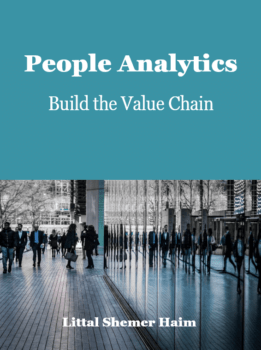





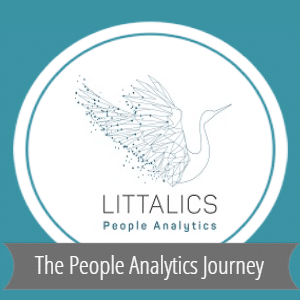
6 thoughts on “People Analytics and HR-Tech Reading List”
היי ליטל. אני מעוניין ללמוד עוד על התחום של.
לאנשים. האם את יכולה להמליץ על טקסט היכרות טוב על הנושא? מתן Analytics
Hi Matan, Considering your experience in BI and advanced analytics (Yep, I read that on your LinkedIn profile), I would recommend you learn more about Human Resources processes. To practice data science in HR, aka People Analytics, expertise in the domain of people processes is valuable. I invite you to read more of my blog, subscribe if you want, and get the spirit of this practice. Also, pick some of the books in this list to learn how to postulate and raise business questions related to people in analytics projects.
More Books! Brilliant reading list by Paul van der Laken, sorted by Categories: Behavioural Psychology, Technology, Ethics, Digital & Data-driven HR, Management, Statistics, People analytics, Programming, and data visualization. Adding it to my summer vacation planning kit… 🙂
Springer has released 65 Machine Learning and Data books for free!
65 books list
Happy to meet many People Analytics colleagues who started their journey to R programming during covid19. No matter if you are a rookie or a senior in R, you’d probably be thrilled to find endless resources, e.g. free books, based on “Bookdown” https://bookdown.org Enjoy! 🙂
Cheers.
Comments are closed.